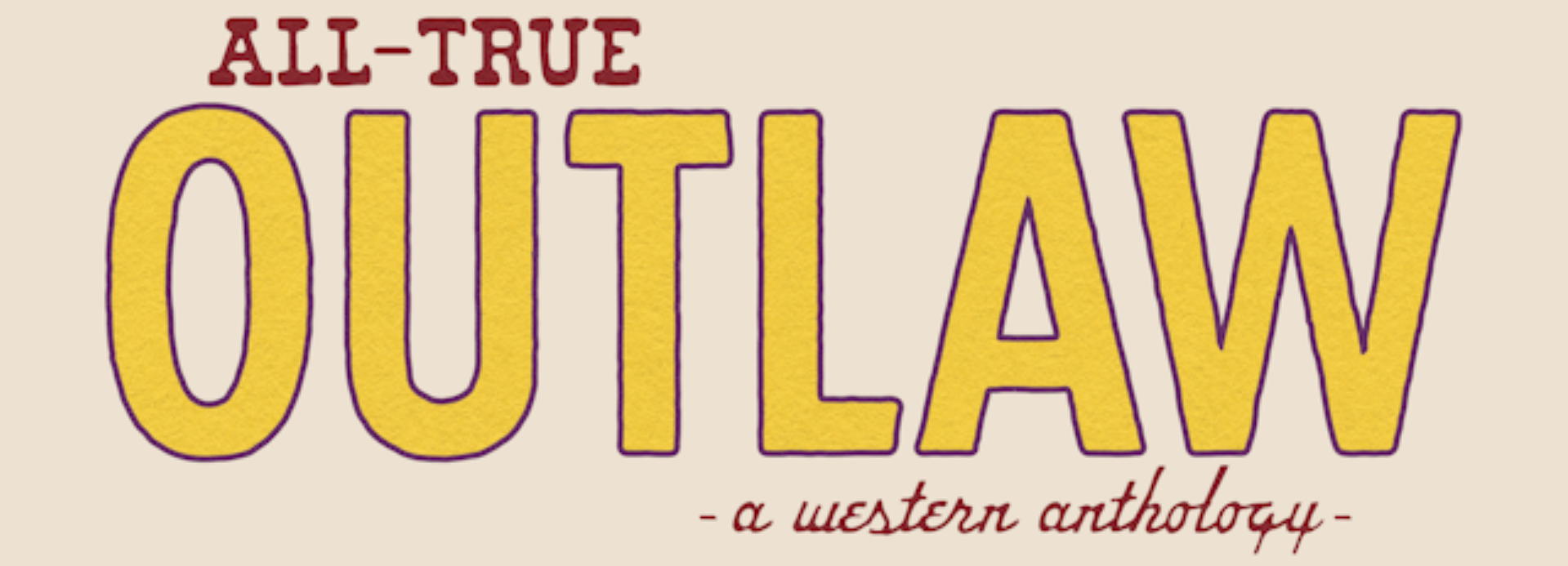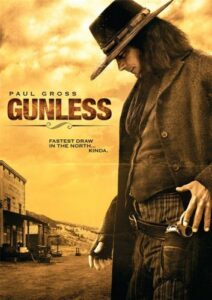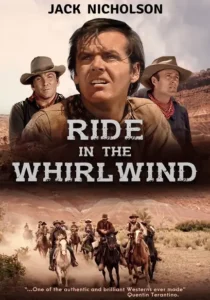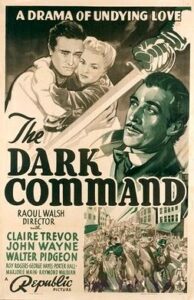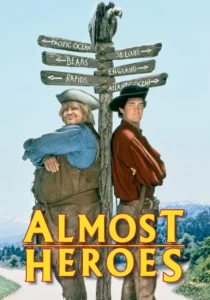Salutations street-toughs,
Welcome back to Project: 100 Westerns! We’re approaching the one-third mark in my endeavor to watch 100 Westerns, and I’m starting to get a little more adventurous in my picks. This quartet might be the most dissimilar group I’ve tackled yet.
Read on, loyal reader!
#28. Last of the Wild Horses – MST3K Version (1948/1994)
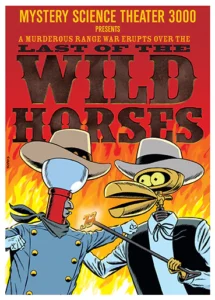
“Here’s where the sepia tone really pays off.”
Since we slid a bit in Sci-fi with this month’s release of Glistening Scar (by Dan Lauer, Amal Desai and myself) I thought it apt to rope in one of my all-time favorite TV shows: Mystery Science Theater 3000.
If you’re not in the know, MST3K stars the literal captive audience of a normal human dude and a pair of robots, documenting their mockery of a real-life bad movie. The features very often tilt toward science-fiction realms, but not always, as is the case of Last of the Wild Horses.
It’s a sloggy movie, gray as hell with terrible audio quality. It follows Duke (James Ellison), a bandit on the path to reform after his recruitment onto a horse farm. There’s a romance with the farmer’s daughter somewhere in there, and a smattering of frontier (in)justice, for good measure. This is a paint-by-numbers Western in just about every way. Except the palette is gray, light-gray, almost white, storm cloud and ash.
For fans of the show, this episode is famous for a Star Trek inspired switcheroo: in a multiversal accident, the series’ villains, Dr. Forrester and his sidekick TV’s Frank (aka The Mads) are the ones in the theater mocking the film through the first segment. It’s a treat for the aficionados, and a hidden gem in the deep catalogue of “experiments” constituting the show’s run.
In terms of the movie inside the TV show, I think one needs the MST3K enhancements to get through this piece of cinema. As Crow complains about halfway through: “The movie’s just starting to mosey now! The pace is rough sledding, and this viewer can only handle so many transition shots of people walking someplace before the scene even bothers to start.
#29. Stars in My Crown (1950)
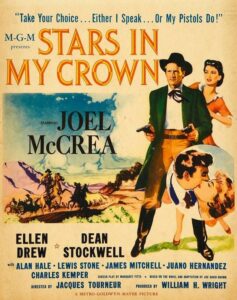
This is labeled Western but is more of a “Southern”. It slants way more toward “historical piece” than “adventure story”.
For the creative conglomerates that produced a film like this, something like Stars in My Crown are the tales of their (great-)grandparents, the happenings still in the living memory of their elders. And indeed, it’s based off of a novel by Joe David Brown, inspired by the memory of his preacher grandfather.
The movie sort of starts out like a traditional Western: a parson named Josiah Gray (Joel McCrea) saunters into the town of Walesburg, Tennessee and immediately enters the local saloon to give a sermon. When the unruly patrons scoff at this attempt, Gray pulls out two handguns and continues to preach at gunpoint. This sets up the parson as a no-nonsense type with a bit of a jagged edge, but honestly, this aura of gruffness dissipates quickly through the first act. Guns and power play only a small part in this story.
Rather, the film revolves around the challenges of Gray to bring more morality and kindness to Walesburg. The slow building A-plot concerns freed slave Uncle “Famous” (Juano Hernandez) as he fends off a wealthy mine owner looking to obtain his land; the B-plot turns on an outbreak of “slow fever” that pits the parson and the town doctor (James Mitchell) against each other in an ideological spat.
The story overall is a bit Pollyanna, but pleasant and put together well. Gray continuously inspires the town through his good nature and the adherence to his values and teachings, and the final scene or two are quite charming and earned. It also gets a few bonus points for one of the best character names I’ve ever seen – Chloroform Wiggins.
#30. Shanghai Noon (2000)
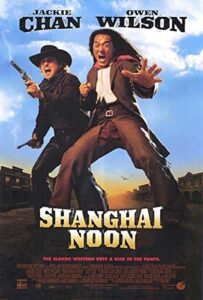
There’s a large bracket of folks who were raised during the Age of (Cable) TV, which I would loosely define from the 1960s until about a decade ago. For these watchers, certain movies or programs seem to be stalwarts of the medium. The reruns were constant, and the stuff that played repeatedly become ingrained into the cultural zeitgeist.
Shanghai Noon certainly fits into that category, for me, at least. This movie appeared in the scrollable channel guide a whole lot in my teen years, but to be honest, I’m not entirely sure I ever really watched it front-to-back. It was definitely one of those movies you sort of flip on and play in the background until you find something better to do.
Honestly, I forgot the reason a station would put a movie like this into heavy rotation is because it’s actually pretty good.
In the current age of Western, where the current offerings slant generally into either “low-budget” or “arthouse” we need more movies like Shanghai Noon. The movie follows the buddy flick formula, teaming two oddballs on a mission full of action and humor. We have Owen Wilson’s Roy O’Bannon – who we discover in the last minute is also somehow Wyatt Earp – a womanizing thief recently expelled from his own gang, and Jackie Chan’s Chon Wang – a play on “John Wayne” – a Chinese Imperial Guard on a mission to save an abducted princess (Lucy Liu). This plot and casting is pretty obviously trying to catch and harness the magic of Chan’s mega hit Rush Hour, and it comes very close to achieving that vibe.
The movie plays off of a lot of the Western tropes for comedic effect, but stops short of satire or parody. It’s an absurd movie, and the tonal quality is just right, for the most part. There are amazing comedic sequences (of note is the scene where Roy and Chon get blitzed in bathtubs) and Chan’s action choreography injects a super fun element into a fairly average series of plot churns.
This is a good popcorn flick, and it almost makes me want to take back what I’ve said previously about the Comedy Western’s effectiveness. There’s a lesson here about what tenor and inspiration this subgenre should take on, and generally the Western needs more high concept ideas and a more high-flying atmosphere if it wants to attract mainstream audiences again.
#31. China 9, Liberty 37 (1978)
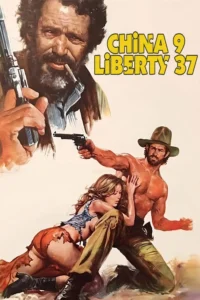
“I need you tonight, and I hate you for it.”
No, you’re not reading the score of an odd football matchup. This methodical Western (with a heavy tint of love story) is led by Fabio Testi and directed by Monte Hellman. It was released in 1978 under the title Amore piombo e furore (“Love, Lead, and Fury”) but didn’t reach the US until 1984.
Basic plot rundown: Mere minutes before his scheduled hanging, gunfighter Clay Drumm is tasked by a railroad company to kill a man whose property they covet. After spending a few days with Matt (Warren Oates) and his wife Catherine (Jenny Agutter), Clay decides against murder…but does engage in an affair with the wife, which leads to the pair fleeing a scorned Matt and his clan. Bullets fly, the damsel changes hands a couple times and the guy on the horse tries to save the day.
The movie leans heavily on extended takes, cheesecake/beefcake and a lively soundtrack. The flavor of the Italian-Spanish Western is as thick as Testi’s accent. It takes a long, long while for the audience to feel the friction of the plot. Maybe a third of the movie is spent introducing us to the characters and their surroundings, and in formulaic fashion, the last third pops with gunfire and sex. What normally keeps a movie like that afloat is either compelling camera work or inspired repartee, neither which isn’t exactly crackling in this. The dubbing and audio is a speck slipshod, as well. I try not to watch with captions but this time I just had to.
The romance at the heart works via the effort of Testi and Agutter. The atmosphere of syrupy lust is sometimes too thick, the attraction between Clayton and Catherine is prominent and immediate. It’s not until much later in the film, after danger has entwined them even further, that you feel their genuine connection and a fear for their romantic future.
I liked China 9, Liberty 37 more than the other Hellman (Ride in a Whirlwind) and Testi (Dead Men Ride) films I’ve previously reviewed for this column. It has a jumbled morality and a bare plot but the steady quality provides enough juice to get you to the ending credits.
Good movie! Though, I would still like to see The People’s Republic of China and Liberty University play football.
This was maybe my smoothest group so far. Nothing felt like a chore.
We have a new comic release on Aug 4th, 2025! A revenge story gone wrong!
And remember to follow on the social accounts: Instagram, Bluesky, X and Facebook! Every like, comment and share helps us exponentially.
Westward!
~Jamil

